Wireless Networking Concepts: Antenna, Multiplexing, and Tech
VerifiedAdded on 2020/03/02
|10
|1697
|38
Report
AI Summary
This report delves into the core concepts of wireless networking, presenting an analysis of various antenna types, including horn, Yagi, and smart antennas, highlighting their strengths, weaknesses, and applications. It also provides a comparative study of multiplexing techniques, specifically CDMA and FDMA, illustrating their operational principles through diagrams. Furthermore, the report examines three recent advanced wireless technologies: Wi-Fi, Bluetooth, and VOIP, detailing their functionalities, advantages, and limitations. The report concludes with a recommendation for smart antennas, emphasizing their potential in future wireless communication systems. The report is well-structured, providing clear explanations and practical applications of the discussed technologies. The document is contributed by a student and available on Desklib, a platform offering AI-based study tools for students, including access to past papers and solved assignments.
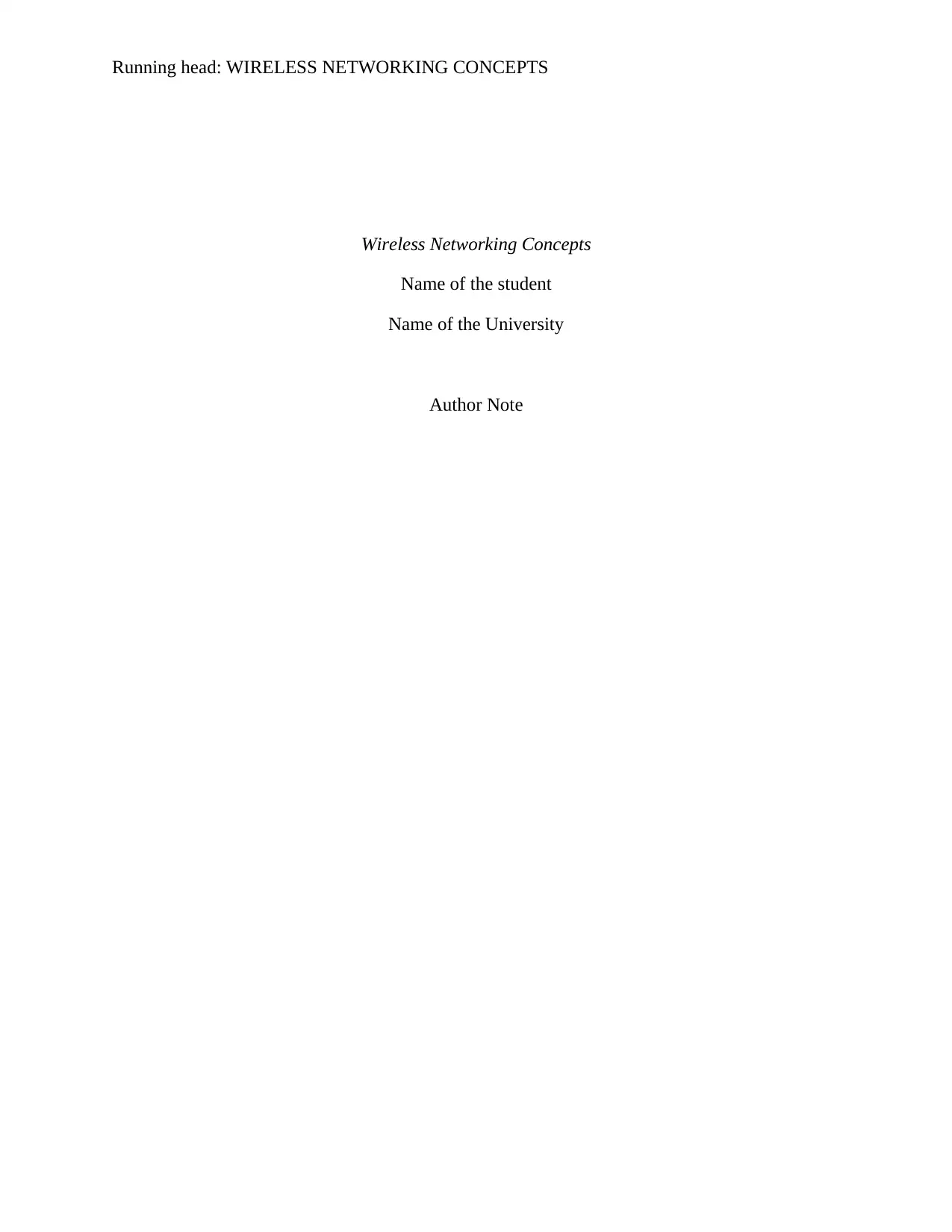
Running head: WIRELESS NETWORKING CONCEPTS
Wireless Networking Concepts
Name of the student
Name of the University
Author Note
Wireless Networking Concepts
Name of the student
Name of the University
Author Note
Paraphrase This Document
Need a fresh take? Get an instant paraphrase of this document with our AI Paraphraser
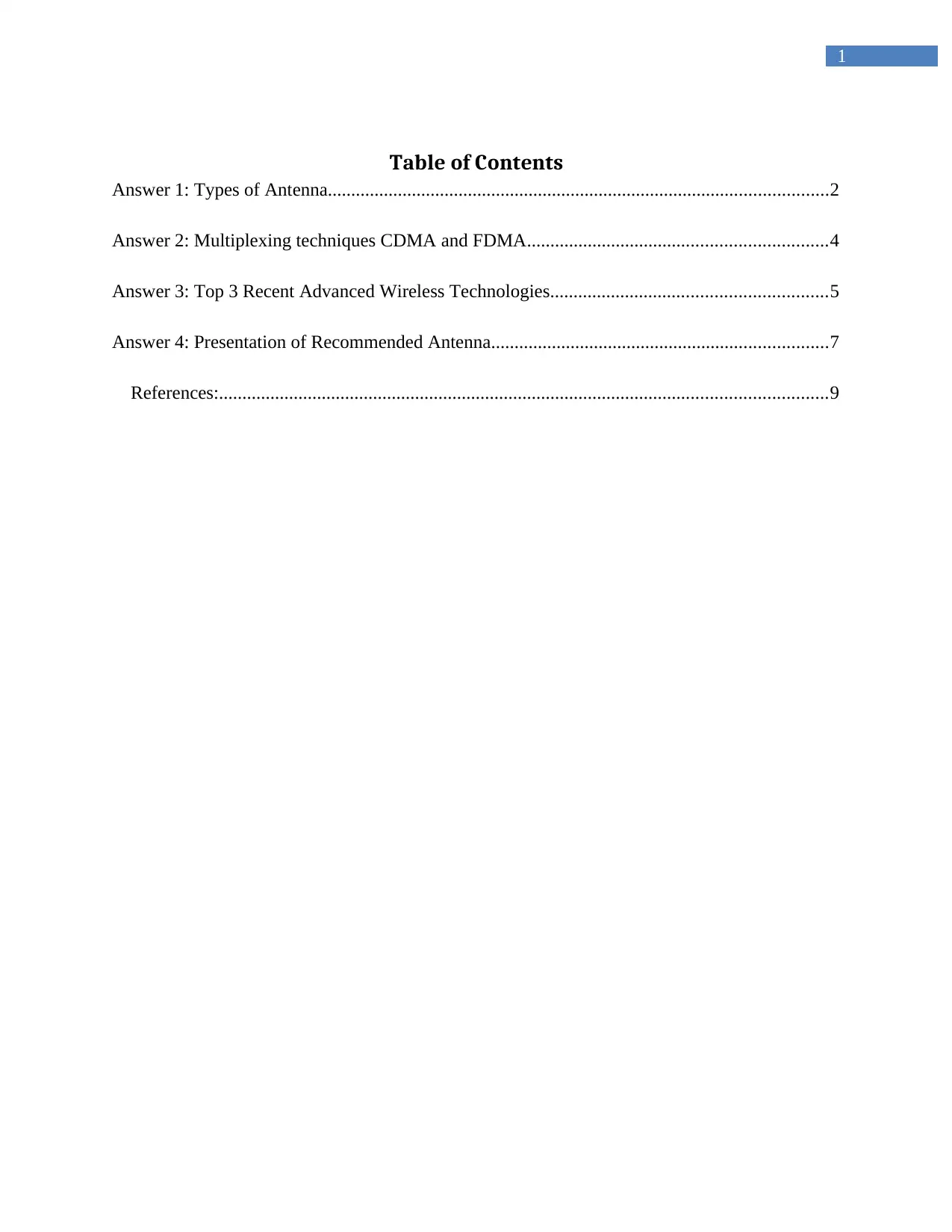
1
Table of Contents
Answer 1: Types of Antenna...........................................................................................................2
Answer 2: Multiplexing techniques CDMA and FDMA................................................................4
Answer 3: Top 3 Recent Advanced Wireless Technologies...........................................................5
Answer 4: Presentation of Recommended Antenna........................................................................7
References:..................................................................................................................................9
Table of Contents
Answer 1: Types of Antenna...........................................................................................................2
Answer 2: Multiplexing techniques CDMA and FDMA................................................................4
Answer 3: Top 3 Recent Advanced Wireless Technologies...........................................................5
Answer 4: Presentation of Recommended Antenna........................................................................7
References:..................................................................................................................................9
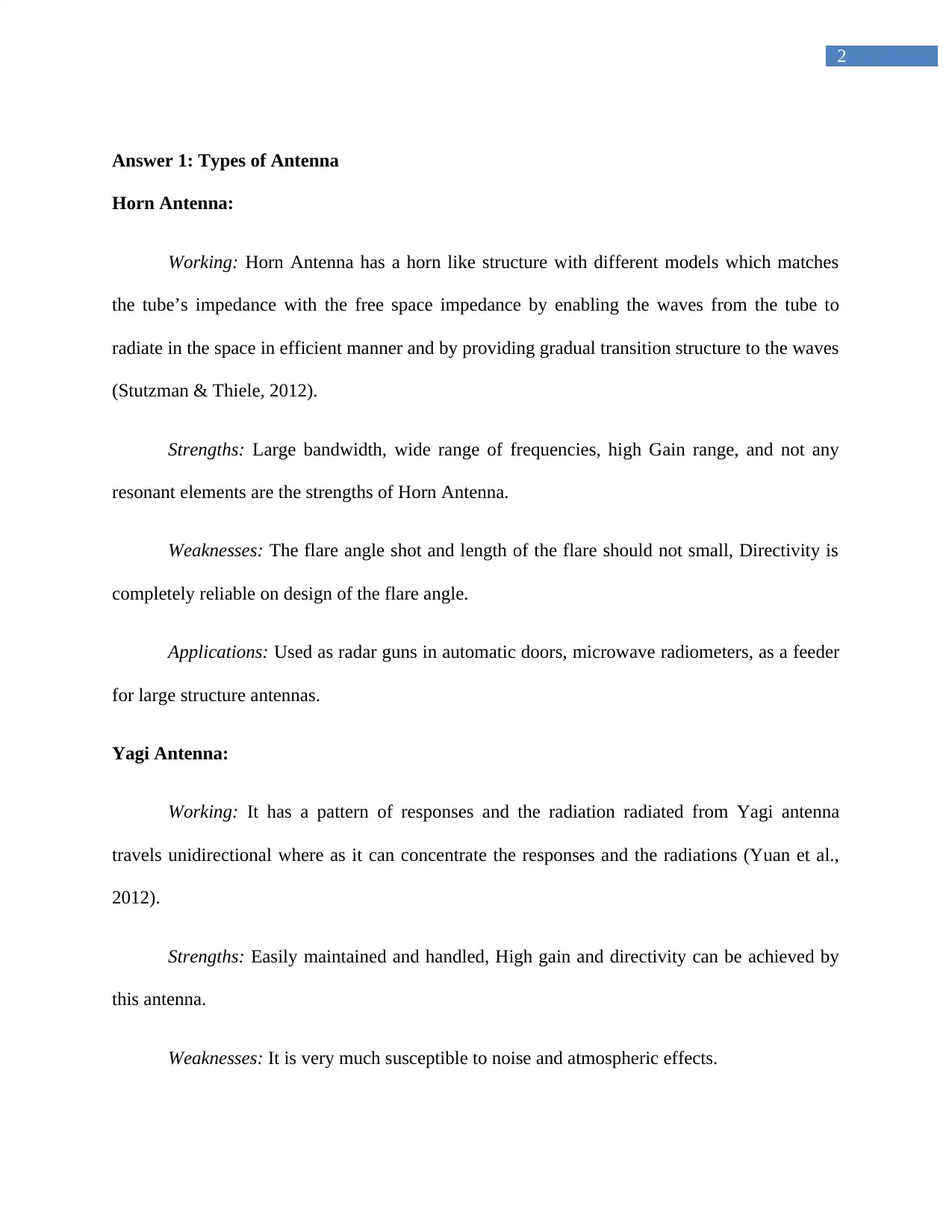
2
Answer 1: Types of Antenna
Horn Antenna:
Working: Horn Antenna has a horn like structure with different models which matches
the tube’s impedance with the free space impedance by enabling the waves from the tube to
radiate in the space in efficient manner and by providing gradual transition structure to the waves
(Stutzman & Thiele, 2012).
Strengths: Large bandwidth, wide range of frequencies, high Gain range, and not any
resonant elements are the strengths of Horn Antenna.
Weaknesses: The flare angle shot and length of the flare should not small, Directivity is
completely reliable on design of the flare angle.
Applications: Used as radar guns in automatic doors, microwave radiometers, as a feeder
for large structure antennas.
Yagi Antenna:
Working: It has a pattern of responses and the radiation radiated from Yagi antenna
travels unidirectional where as it can concentrate the responses and the radiations (Yuan et al.,
2012).
Strengths: Easily maintained and handled, High gain and directivity can be achieved by
this antenna.
Weaknesses: It is very much susceptible to noise and atmospheric effects.
Answer 1: Types of Antenna
Horn Antenna:
Working: Horn Antenna has a horn like structure with different models which matches
the tube’s impedance with the free space impedance by enabling the waves from the tube to
radiate in the space in efficient manner and by providing gradual transition structure to the waves
(Stutzman & Thiele, 2012).
Strengths: Large bandwidth, wide range of frequencies, high Gain range, and not any
resonant elements are the strengths of Horn Antenna.
Weaknesses: The flare angle shot and length of the flare should not small, Directivity is
completely reliable on design of the flare angle.
Applications: Used as radar guns in automatic doors, microwave radiometers, as a feeder
for large structure antennas.
Yagi Antenna:
Working: It has a pattern of responses and the radiation radiated from Yagi antenna
travels unidirectional where as it can concentrate the responses and the radiations (Yuan et al.,
2012).
Strengths: Easily maintained and handled, High gain and directivity can be achieved by
this antenna.
Weaknesses: It is very much susceptible to noise and atmospheric effects.
⊘ This is a preview!⊘
Do you want full access?
Subscribe today to unlock all pages.

Trusted by 1+ million students worldwide
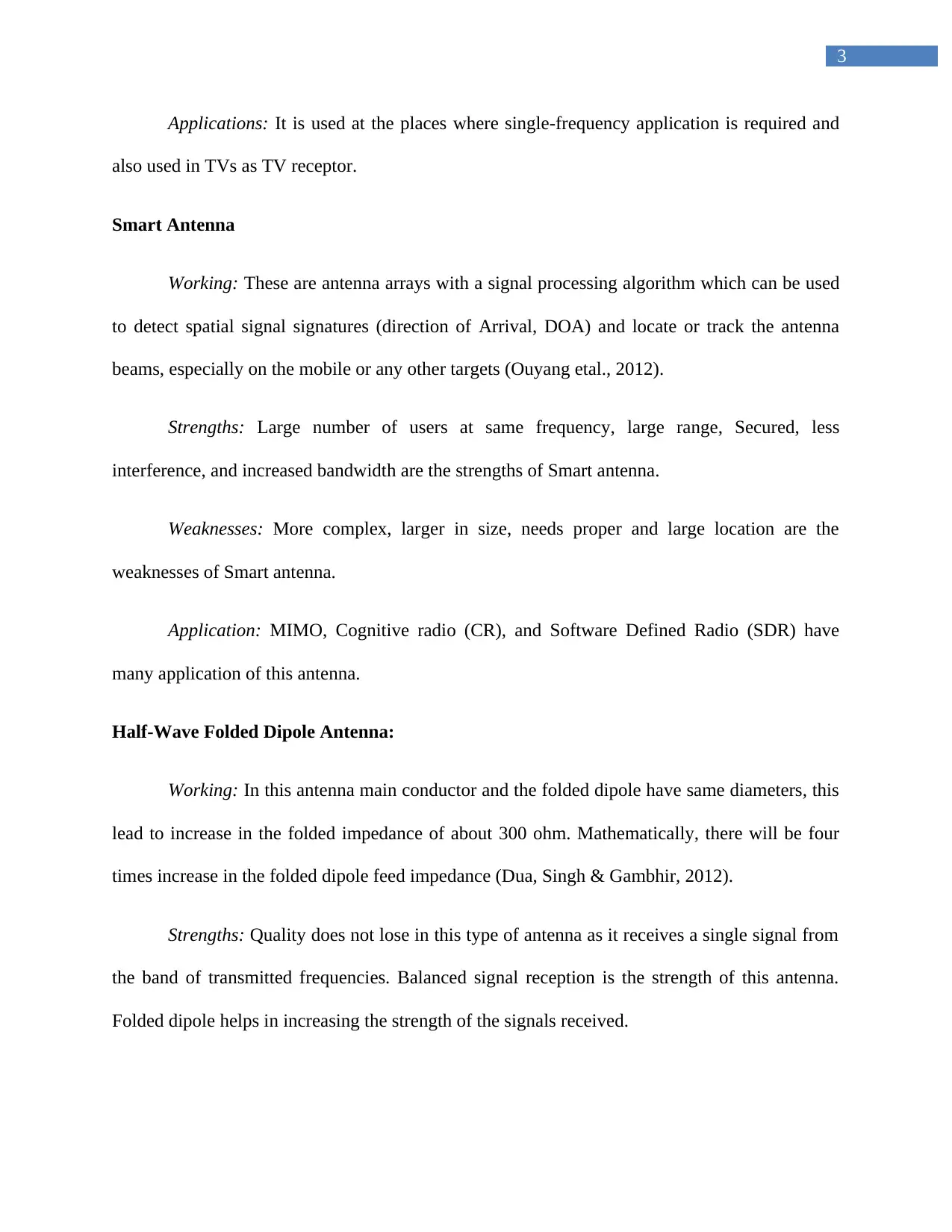
3
Applications: It is used at the places where single-frequency application is required and
also used in TVs as TV receptor.
Smart Antenna
Working: These are antenna arrays with a signal processing algorithm which can be used
to detect spatial signal signatures (direction of Arrival, DOA) and locate or track the antenna
beams, especially on the mobile or any other targets (Ouyang etal., 2012).
Strengths: Large number of users at same frequency, large range, Secured, less
interference, and increased bandwidth are the strengths of Smart antenna.
Weaknesses: More complex, larger in size, needs proper and large location are the
weaknesses of Smart antenna.
Application: MIMO, Cognitive radio (CR), and Software Defined Radio (SDR) have
many application of this antenna.
Half-Wave Folded Dipole Antenna:
Working: In this antenna main conductor and the folded dipole have same diameters, this
lead to increase in the folded impedance of about 300 ohm. Mathematically, there will be four
times increase in the folded dipole feed impedance (Dua, Singh & Gambhir, 2012).
Strengths: Quality does not lose in this type of antenna as it receives a single signal from
the band of transmitted frequencies. Balanced signal reception is the strength of this antenna.
Folded dipole helps in increasing the strength of the signals received.
Applications: It is used at the places where single-frequency application is required and
also used in TVs as TV receptor.
Smart Antenna
Working: These are antenna arrays with a signal processing algorithm which can be used
to detect spatial signal signatures (direction of Arrival, DOA) and locate or track the antenna
beams, especially on the mobile or any other targets (Ouyang etal., 2012).
Strengths: Large number of users at same frequency, large range, Secured, less
interference, and increased bandwidth are the strengths of Smart antenna.
Weaknesses: More complex, larger in size, needs proper and large location are the
weaknesses of Smart antenna.
Application: MIMO, Cognitive radio (CR), and Software Defined Radio (SDR) have
many application of this antenna.
Half-Wave Folded Dipole Antenna:
Working: In this antenna main conductor and the folded dipole have same diameters, this
lead to increase in the folded impedance of about 300 ohm. Mathematically, there will be four
times increase in the folded dipole feed impedance (Dua, Singh & Gambhir, 2012).
Strengths: Quality does not lose in this type of antenna as it receives a single signal from
the band of transmitted frequencies. Balanced signal reception is the strength of this antenna.
Folded dipole helps in increasing the strength of the signals received.
Paraphrase This Document
Need a fresh take? Get an instant paraphrase of this document with our AI Paraphraser
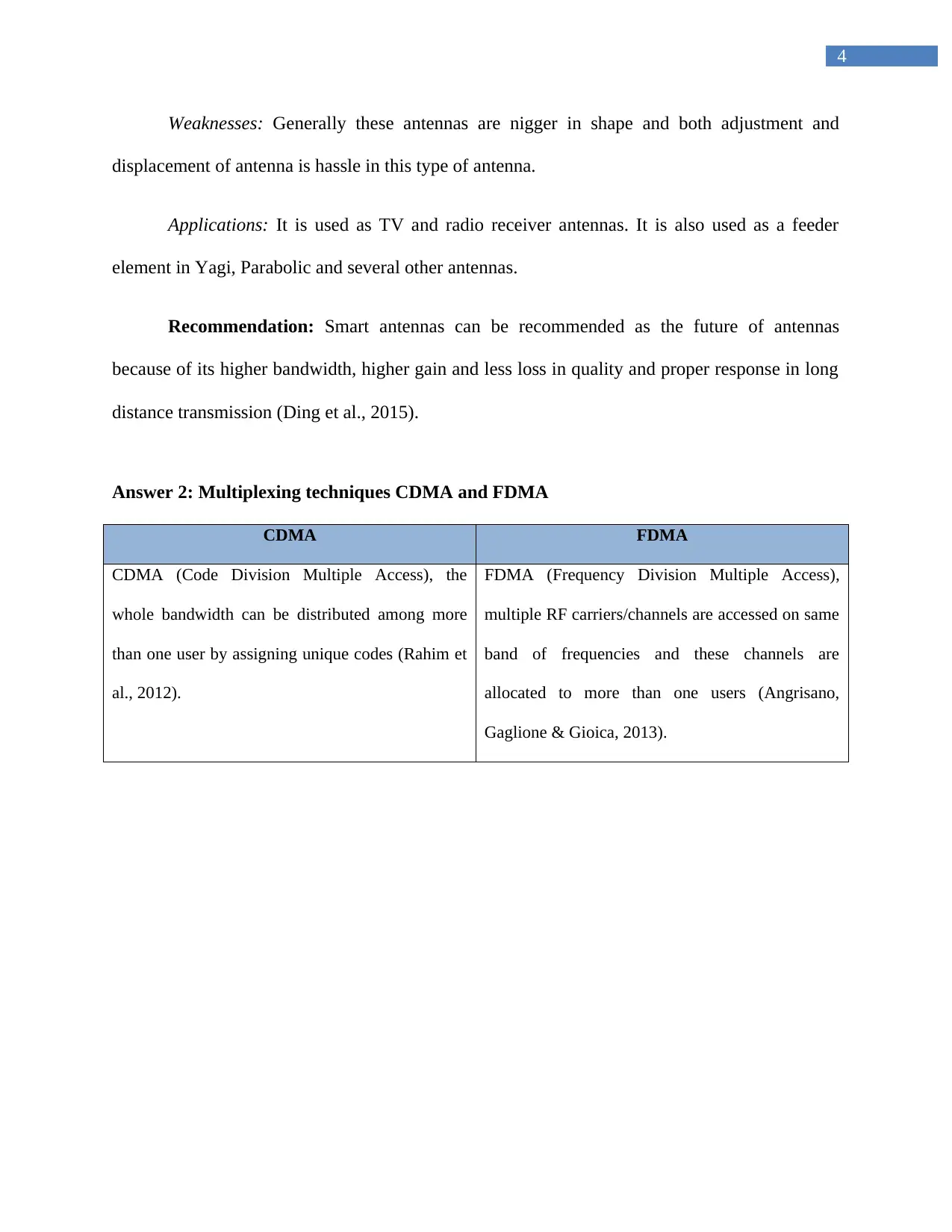
4
Weaknesses: Generally these antennas are nigger in shape and both adjustment and
displacement of antenna is hassle in this type of antenna.
Applications: It is used as TV and radio receiver antennas. It is also used as a feeder
element in Yagi, Parabolic and several other antennas.
Recommendation: Smart antennas can be recommended as the future of antennas
because of its higher bandwidth, higher gain and less loss in quality and proper response in long
distance transmission (Ding et al., 2015).
Answer 2: Multiplexing techniques CDMA and FDMA
CDMA FDMA
CDMA (Code Division Multiple Access), the
whole bandwidth can be distributed among more
than one user by assigning unique codes (Rahim et
al., 2012).
FDMA (Frequency Division Multiple Access),
multiple RF carriers/channels are accessed on same
band of frequencies and these channels are
allocated to more than one users (Angrisano,
Gaglione & Gioica, 2013).
Weaknesses: Generally these antennas are nigger in shape and both adjustment and
displacement of antenna is hassle in this type of antenna.
Applications: It is used as TV and radio receiver antennas. It is also used as a feeder
element in Yagi, Parabolic and several other antennas.
Recommendation: Smart antennas can be recommended as the future of antennas
because of its higher bandwidth, higher gain and less loss in quality and proper response in long
distance transmission (Ding et al., 2015).
Answer 2: Multiplexing techniques CDMA and FDMA
CDMA FDMA
CDMA (Code Division Multiple Access), the
whole bandwidth can be distributed among more
than one user by assigning unique codes (Rahim et
al., 2012).
FDMA (Frequency Division Multiple Access),
multiple RF carriers/channels are accessed on same
band of frequencies and these channels are
allocated to more than one users (Angrisano,
Gaglione & Gioica, 2013).
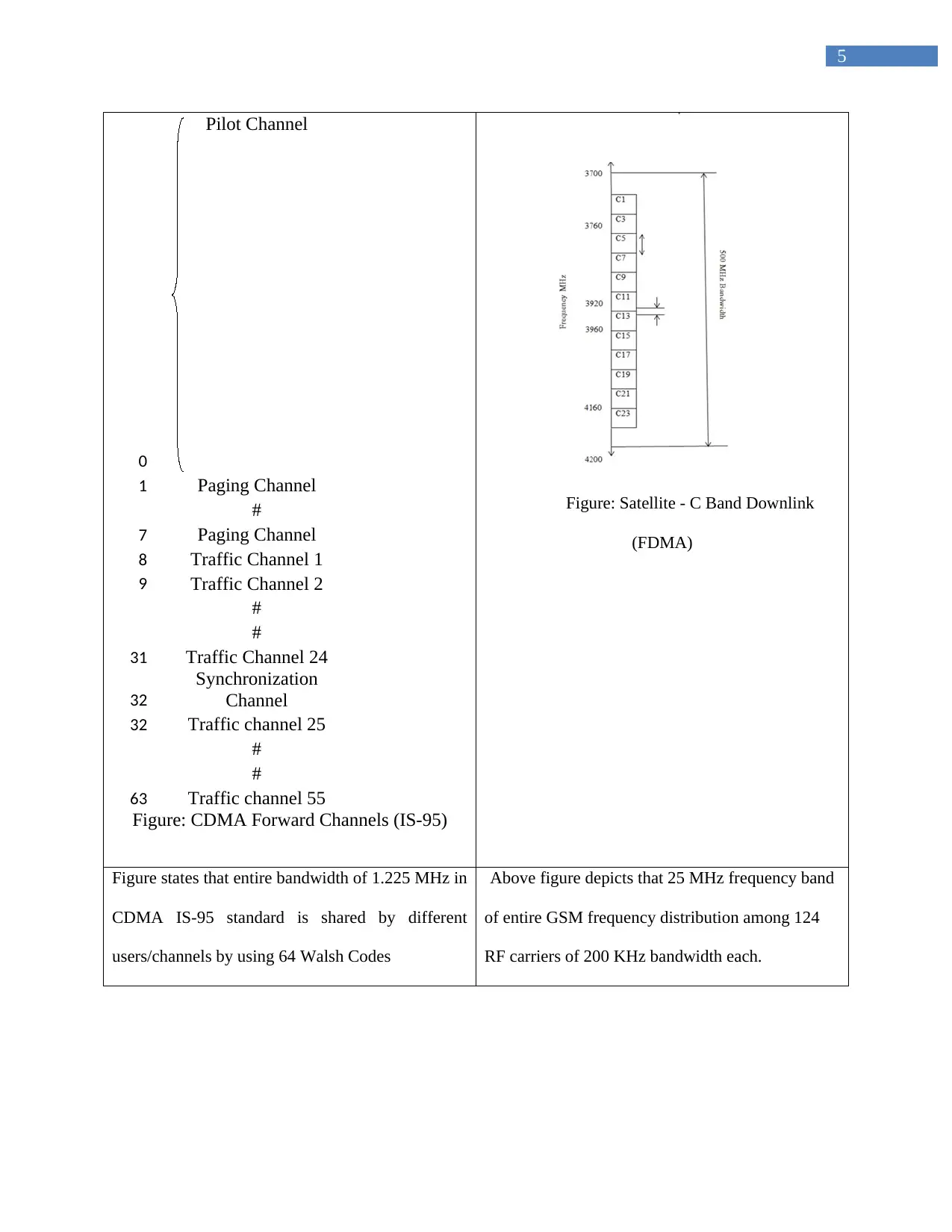
5
0
Pilot Channel
1 Paging Channel
#
7 Paging Channel
8 Traffic Channel 1
9 Traffic Channel 2
#
#
31 Traffic Channel 24
32
Synchronization
Channel
32 Traffic channel 25
#
#
63 Traffic channel 55
Figure: CDMA Forward Channels (IS-95)
Figure: Satellite - C Band Downlink
(FDMA)
Figure states that entire bandwidth of 1.225 MHz in
CDMA IS-95 standard is shared by different
users/channels by using 64 Walsh Codes
Above figure depicts that 25 MHz frequency band
of entire GSM frequency distribution among 124
RF carriers of 200 KHz bandwidth each.
0
Pilot Channel
1 Paging Channel
#
7 Paging Channel
8 Traffic Channel 1
9 Traffic Channel 2
#
#
31 Traffic Channel 24
32
Synchronization
Channel
32 Traffic channel 25
#
#
63 Traffic channel 55
Figure: CDMA Forward Channels (IS-95)
Figure: Satellite - C Band Downlink
(FDMA)
Figure states that entire bandwidth of 1.225 MHz in
CDMA IS-95 standard is shared by different
users/channels by using 64 Walsh Codes
Above figure depicts that 25 MHz frequency band
of entire GSM frequency distribution among 124
RF carriers of 200 KHz bandwidth each.
⊘ This is a preview!⊘
Do you want full access?
Subscribe today to unlock all pages.

Trusted by 1+ million students worldwide
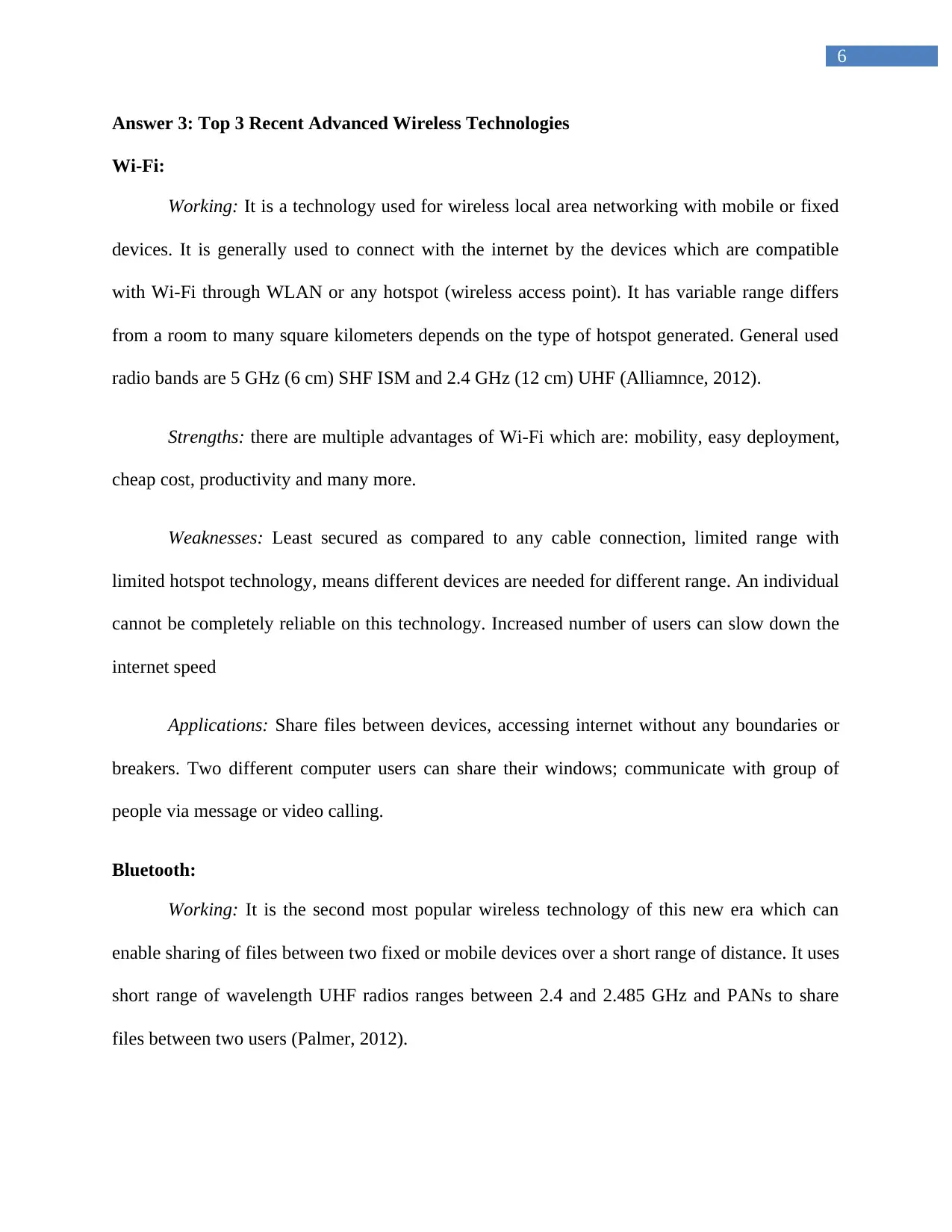
6
Answer 3: Top 3 Recent Advanced Wireless Technologies
Wi-Fi:
Working: It is a technology used for wireless local area networking with mobile or fixed
devices. It is generally used to connect with the internet by the devices which are compatible
with Wi-Fi through WLAN or any hotspot (wireless access point). It has variable range differs
from a room to many square kilometers depends on the type of hotspot generated. General used
radio bands are 5 GHz (6 cm) SHF ISM and 2.4 GHz (12 cm) UHF (Alliamnce, 2012).
Strengths: there are multiple advantages of Wi-Fi which are: mobility, easy deployment,
cheap cost, productivity and many more.
Weaknesses: Least secured as compared to any cable connection, limited range with
limited hotspot technology, means different devices are needed for different range. An individual
cannot be completely reliable on this technology. Increased number of users can slow down the
internet speed
Applications: Share files between devices, accessing internet without any boundaries or
breakers. Two different computer users can share their windows; communicate with group of
people via message or video calling.
Bluetooth:
Working: It is the second most popular wireless technology of this new era which can
enable sharing of files between two fixed or mobile devices over a short range of distance. It uses
short range of wavelength UHF radios ranges between 2.4 and 2.485 GHz and PANs to share
files between two users (Palmer, 2012).
Answer 3: Top 3 Recent Advanced Wireless Technologies
Wi-Fi:
Working: It is a technology used for wireless local area networking with mobile or fixed
devices. It is generally used to connect with the internet by the devices which are compatible
with Wi-Fi through WLAN or any hotspot (wireless access point). It has variable range differs
from a room to many square kilometers depends on the type of hotspot generated. General used
radio bands are 5 GHz (6 cm) SHF ISM and 2.4 GHz (12 cm) UHF (Alliamnce, 2012).
Strengths: there are multiple advantages of Wi-Fi which are: mobility, easy deployment,
cheap cost, productivity and many more.
Weaknesses: Least secured as compared to any cable connection, limited range with
limited hotspot technology, means different devices are needed for different range. An individual
cannot be completely reliable on this technology. Increased number of users can slow down the
internet speed
Applications: Share files between devices, accessing internet without any boundaries or
breakers. Two different computer users can share their windows; communicate with group of
people via message or video calling.
Bluetooth:
Working: It is the second most popular wireless technology of this new era which can
enable sharing of files between two fixed or mobile devices over a short range of distance. It uses
short range of wavelength UHF radios ranges between 2.4 and 2.485 GHz and PANs to share
files between two users (Palmer, 2012).
Paraphrase This Document
Need a fresh take? Get an instant paraphrase of this document with our AI Paraphraser
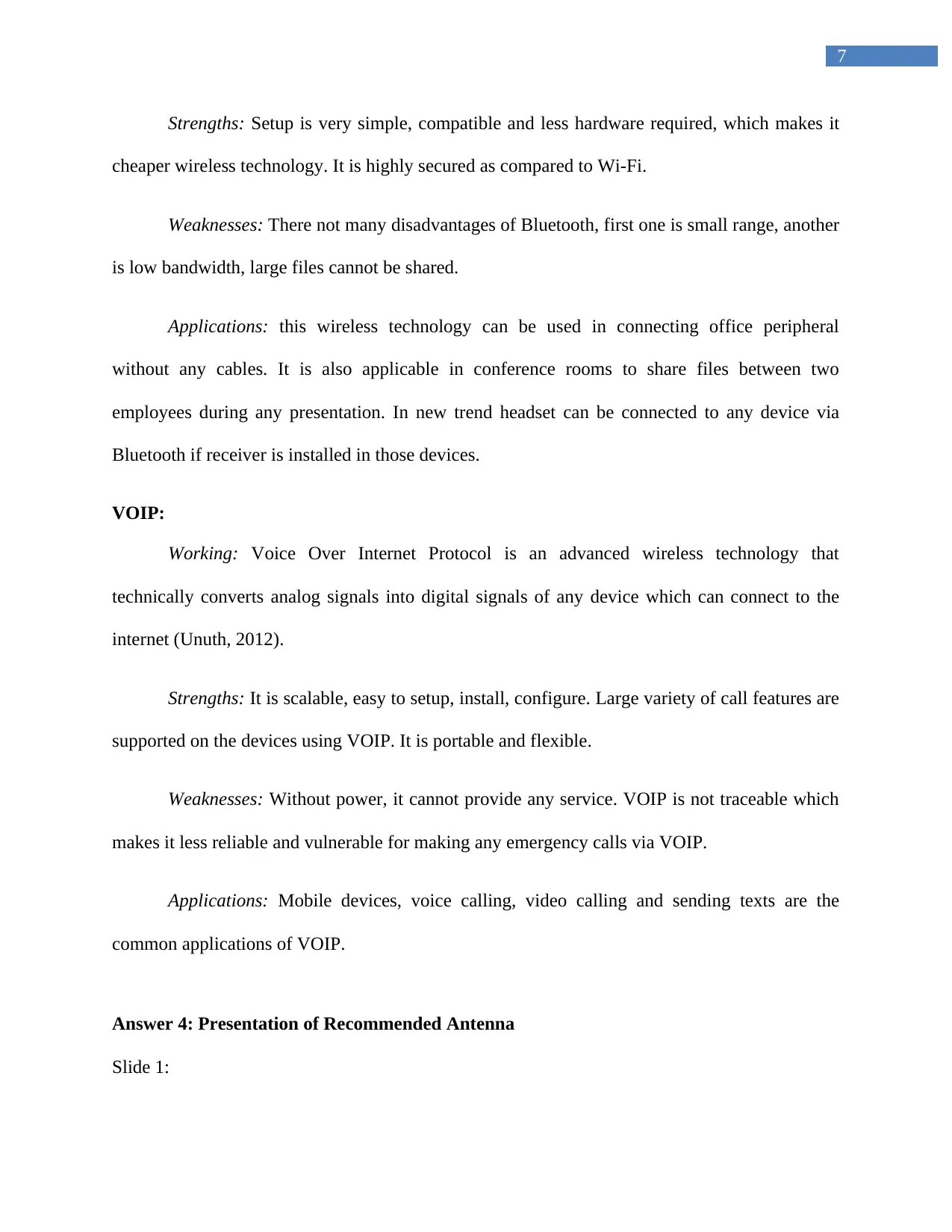
7
Strengths: Setup is very simple, compatible and less hardware required, which makes it
cheaper wireless technology. It is highly secured as compared to Wi-Fi.
Weaknesses: There not many disadvantages of Bluetooth, first one is small range, another
is low bandwidth, large files cannot be shared.
Applications: this wireless technology can be used in connecting office peripheral
without any cables. It is also applicable in conference rooms to share files between two
employees during any presentation. In new trend headset can be connected to any device via
Bluetooth if receiver is installed in those devices.
VOIP:
Working: Voice Over Internet Protocol is an advanced wireless technology that
technically converts analog signals into digital signals of any device which can connect to the
internet (Unuth, 2012).
Strengths: It is scalable, easy to setup, install, configure. Large variety of call features are
supported on the devices using VOIP. It is portable and flexible.
Weaknesses: Without power, it cannot provide any service. VOIP is not traceable which
makes it less reliable and vulnerable for making any emergency calls via VOIP.
Applications: Mobile devices, voice calling, video calling and sending texts are the
common applications of VOIP.
Answer 4: Presentation of Recommended Antenna
Slide 1:
Strengths: Setup is very simple, compatible and less hardware required, which makes it
cheaper wireless technology. It is highly secured as compared to Wi-Fi.
Weaknesses: There not many disadvantages of Bluetooth, first one is small range, another
is low bandwidth, large files cannot be shared.
Applications: this wireless technology can be used in connecting office peripheral
without any cables. It is also applicable in conference rooms to share files between two
employees during any presentation. In new trend headset can be connected to any device via
Bluetooth if receiver is installed in those devices.
VOIP:
Working: Voice Over Internet Protocol is an advanced wireless technology that
technically converts analog signals into digital signals of any device which can connect to the
internet (Unuth, 2012).
Strengths: It is scalable, easy to setup, install, configure. Large variety of call features are
supported on the devices using VOIP. It is portable and flexible.
Weaknesses: Without power, it cannot provide any service. VOIP is not traceable which
makes it less reliable and vulnerable for making any emergency calls via VOIP.
Applications: Mobile devices, voice calling, video calling and sending texts are the
common applications of VOIP.
Answer 4: Presentation of Recommended Antenna
Slide 1:
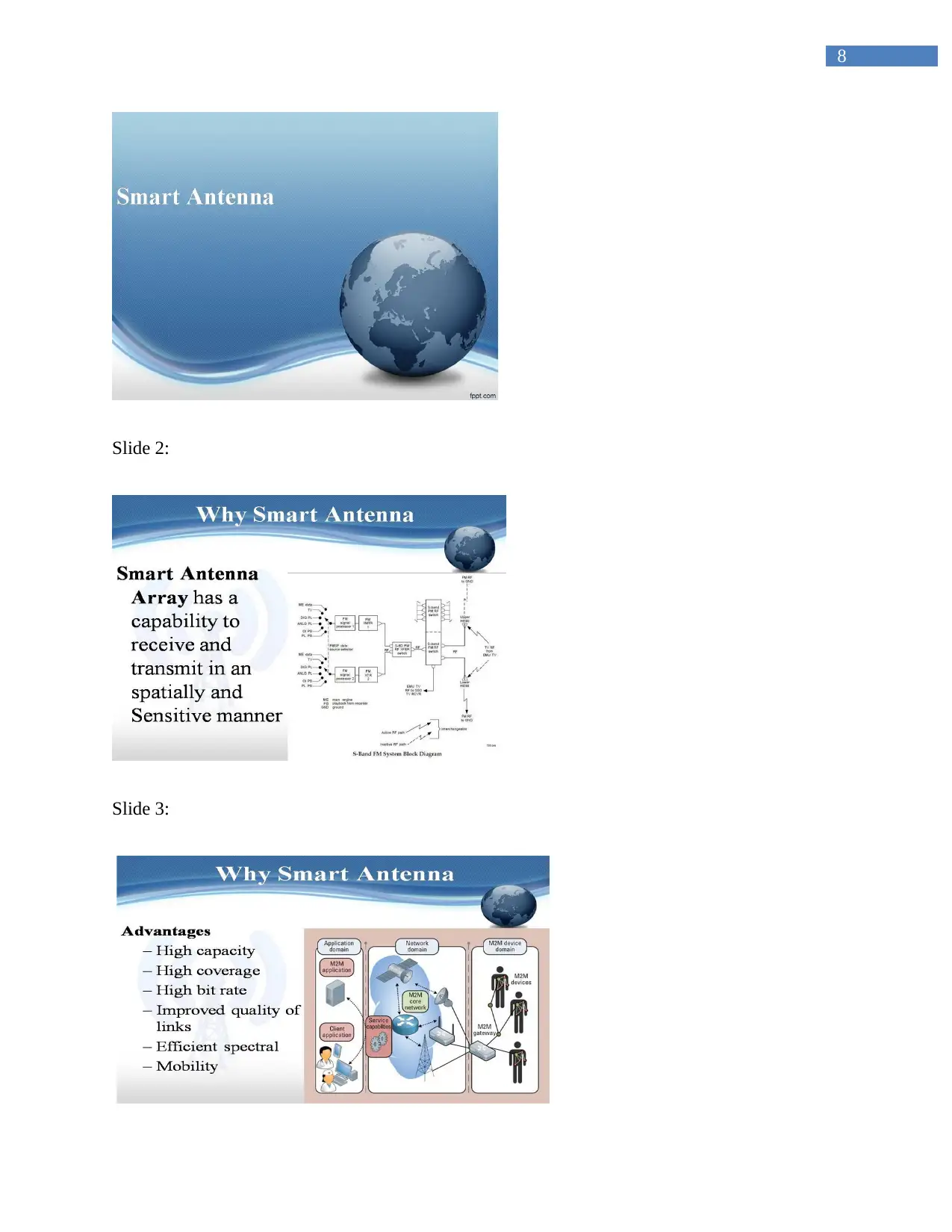
8
Slide 2:
Slide 3:
Slide 2:
Slide 3:
⊘ This is a preview!⊘
Do you want full access?
Subscribe today to unlock all pages.

Trusted by 1+ million students worldwide
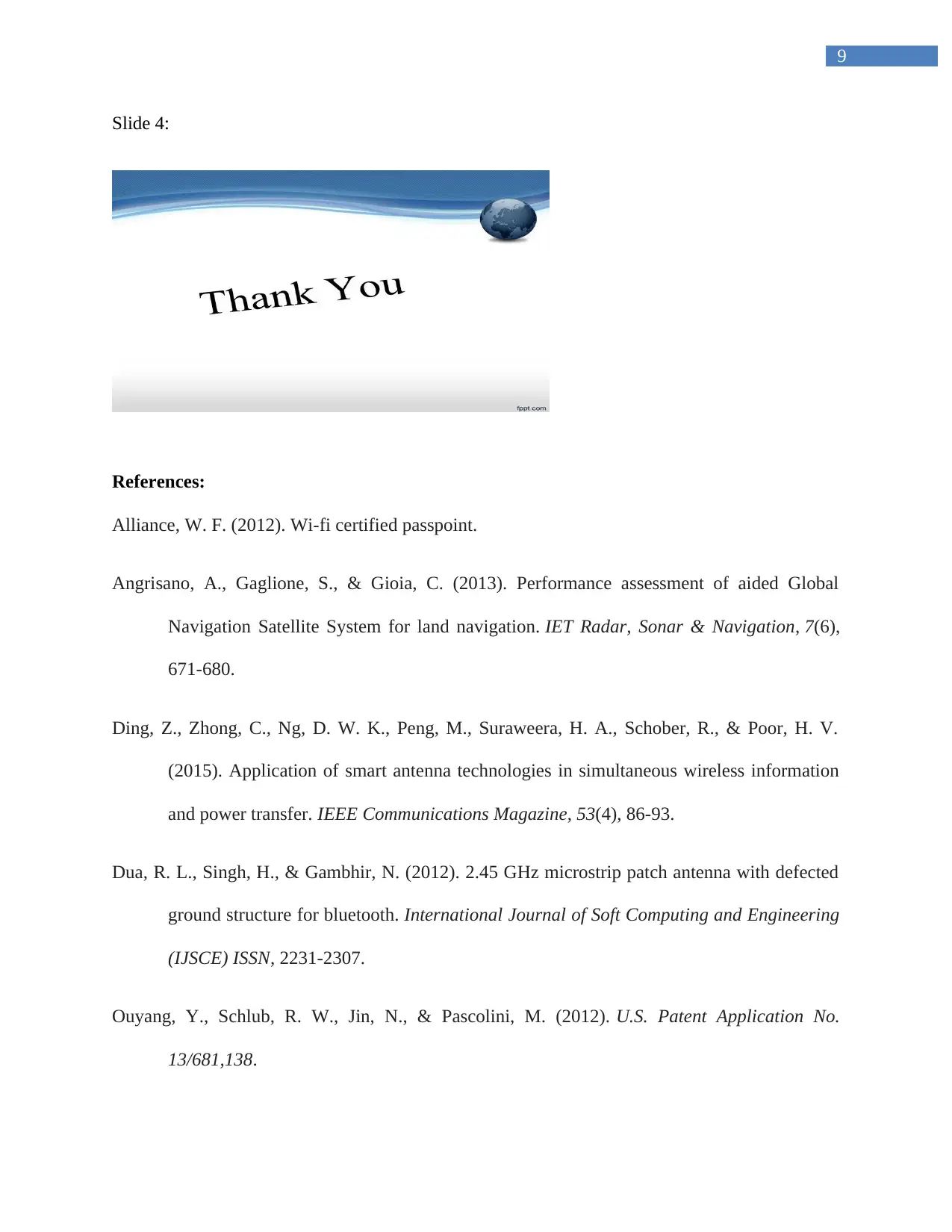
9
Slide 4:
References:
Alliance, W. F. (2012). Wi-fi certified passpoint.
Angrisano, A., Gaglione, S., & Gioia, C. (2013). Performance assessment of aided Global
Navigation Satellite System for land navigation. IET Radar, Sonar & Navigation, 7(6),
671-680.
Ding, Z., Zhong, C., Ng, D. W. K., Peng, M., Suraweera, H. A., Schober, R., & Poor, H. V.
(2015). Application of smart antenna technologies in simultaneous wireless information
and power transfer. IEEE Communications Magazine, 53(4), 86-93.
Dua, R. L., Singh, H., & Gambhir, N. (2012). 2.45 GHz microstrip patch antenna with defected
ground structure for bluetooth. International Journal of Soft Computing and Engineering
(IJSCE) ISSN, 2231-2307.
Ouyang, Y., Schlub, R. W., Jin, N., & Pascolini, M. (2012). U.S. Patent Application No.
13/681,138.
Slide 4:
References:
Alliance, W. F. (2012). Wi-fi certified passpoint.
Angrisano, A., Gaglione, S., & Gioia, C. (2013). Performance assessment of aided Global
Navigation Satellite System for land navigation. IET Radar, Sonar & Navigation, 7(6),
671-680.
Ding, Z., Zhong, C., Ng, D. W. K., Peng, M., Suraweera, H. A., Schober, R., & Poor, H. V.
(2015). Application of smart antenna technologies in simultaneous wireless information
and power transfer. IEEE Communications Magazine, 53(4), 86-93.
Dua, R. L., Singh, H., & Gambhir, N. (2012). 2.45 GHz microstrip patch antenna with defected
ground structure for bluetooth. International Journal of Soft Computing and Engineering
(IJSCE) ISSN, 2231-2307.
Ouyang, Y., Schlub, R. W., Jin, N., & Pascolini, M. (2012). U.S. Patent Application No.
13/681,138.
1 out of 10
Related Documents
Your All-in-One AI-Powered Toolkit for Academic Success.
+13062052269
info@desklib.com
Available 24*7 on WhatsApp / Email
![[object Object]](/_next/static/media/star-bottom.7253800d.svg)
Unlock your academic potential
Copyright © 2020–2025 A2Z Services. All Rights Reserved. Developed and managed by ZUCOL.





